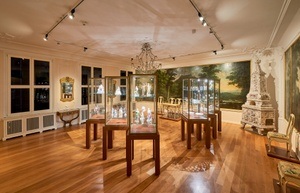Farbversunken | Ulrike Brockmann & Ulrik Happy Dannenberg
In the organizer's words:
ULRIK HAPPY DANNENBERG
Experts who see works by Ulrik Happy Dannenberg say "pop". But what kind of "pop"? Neo, retro or completely new. My impression now is that this category doesn't work here, and that's not because of Dannenberg, but because of a fundamental flaw in the concept and in our thinking about image consumption.
Images always refer to other images. That's the way it is in pop, or so the art historians tell us. But that was already the case when the first picture was painted. Imagine that at some point in a cave, someone painted something on a wall. And it only became a picture because someone else said: "Looks like". So the images are already in our heads before they are painted, whether 30,000 years ago or today. It is worth thinking about this, as the anthropological conditions have not changed, even if there are probably more pictures today (which, by the way, could be debated).
And this is precisely why Dannenberg's work differs from what is commonly called "pop". First and foremost, he does not refer to images that we are familiar with; they are not "soup cans", but work much more subtly with viewing habits and viewing experiences and with something that is missing from the debate, because when we think of images we only ever think of infinitely reproducible surfaces. And this is a sensual aspect that goes far beyond mere seeing. Dannenberg's art is not about the interchangeability of motifs, about the fact that there is "high" and "low", but conversely about the fantastic visual splendor that an object acquires when it is painted in synthetic resin by this artist. This splendor is extremely media-resistant - nothing of it remains in a picture.
A photo only shows the motif (gummy bear or flower), but I have known Dannenberg's work for a long time and believe that it is less and less about the motifs. And art that is not about motifs has to be seen for what it really is.
ULRIKE BROCKMANN
In her works, she works with the effect of color. As simple as it sounds, the subject is complex. What effect does one color have on another? What materiality, what light properties are inherent in a color? How does it change when it enters into a relationship with other colors? Ulrike Brockmann explores these and other questions in her works.
She finds inspiration for her individual works and groups of works in everyday life. They are color impressions that we unconsciously experience thousands of times a day. Ulrike Brockmann has a very conscious
perception of color, a first impulse of color is enough to arouse her curiosity. In her painterly work, she explores various ways of encountering color. Her approach often follows fixed rules, for example the division of space is determined from the outset . Each color is assigned its own space, either on one support or on two separate ones. In the next step, Ulrike Brockmann works out the coherence of the colors. The color tones are applied in many different layers until the color intensity and effect is harmonious. The painted surfaces can be opaque or have a lively play of colors. The colors overlap, form counterpoints to each other, complement each other. Inserts are created that are sometimes harmonious, sometimes disharmonious.
These refractions of the works represent a special attraction: Tensions and unusual color combinations emerge; a dialogue between the color partners involved is created.
As a viewer, I enter into this dialog with my own personal perception of color. Over time, my perception changes, color spectrums become visible and I immerse myself more deeply in the painting.
The processed surface is part of the creative moment of the works. Ulrike Brockmann works with palette knife and self-made tamponages. She uses these tools to apply the paint to the support with pressure . She works with both acrylic and oil paint. Both paint systems present their own unique challenges. While one requires very fast work , the other allows for a slower working process, butrequires significantly longer drying times.











